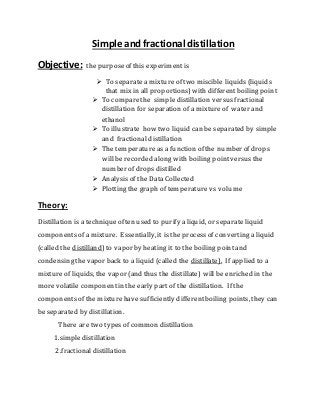
Simple and fractional distillation
- 1. Simple and fractional distillation Objective: the purposeof this experimentis To separate a mixture of two miscible liquids(liquids that mix in all proportions)with differentboiling point To comparethe simple distillation versusfractional distillation for separation of a mixtureof water and ethanol To illustrate how two liquid can be separated by simple and fractional distillation The temperatureas a function of the number of drops will be recorded along with boiling pointversusthe number of dropsdistilled Analysisof the Data Collected Plotting the graph of temperaturevs volume Theory: Distillation is a technique often used to purify aliquid, or separate liquid componentsof a mixture. Essentially, it is the processof convertinga liquid (called the distilland)to vapor by heating it to the boiling pointand condensingthe vapor back to a liquid (called the distillate). If applied to a mixtureof liquids, the vapor (and thus the distillate) will be enriched in the morevolatile componentin the early part of the distillation. If the componentsof the mixturehave sufficiently differentboiling points, they can be separated by distillation. There are two typesof common distillation 1.simpledistillation 2.fractionaldistillation
- 2. 1. Simple distillation: is the process used to purify liquidsby bringing them to their boiling point, and then collecting and condensingback to liquid. : is carried out usinga distilling flask to which a thermometer is fitted by meansof a cork or a ground glass joint .simpledistillation is usefulwhen only a small amountof impurity ispresentor when the liquids to be separated have widely differentboiling points. 2.Fractional distillation: isthe process of heating up a mixture containing differentsubstances with differentboiling point. : is a separation of a liquid mixture into fractionsdifferingin boiling point (and hence chemical composition) by means of distillation, typically usinga fractionating column : Vapors from a boiling solution are passed along a column. The temperature of the column gradually decreasesalongits length. Componentswith a higher boiling points condenseon the column and return to the solution; components with a lower boiling points passthrough the column and are collected. Material Simple distillation fractional distillation 1. contaminated 50 ml of ethanol 1. Condenser& measuring cylinder 2.thermometer 2. Water bath 3.collection flask and measuringcylinder 3. thermometer 4.water bath 4.50 ml of water and 50 ml of ethanol 5 condenser 5.pen and note book 6.boiling chips 6.Fractionalcolumn and 7.adapter 7.boilingchips 8.pen and notebook 8.glass bud
- 3. Procedure Simpledistillation 1. The water bath was prepared 2 50 mlof contaminated ethanol wasmeasured usingmeasuringcylinder 3. the measured contaminated ethanol was placed in to water bath 4. boiling chips was added to vaporizeonly the component that needs to be distilled 5.the thermometer was placed to record the temperature 6.the distillate was collected in collection flask and recorded the boiling point after every 5 ml Fractional distillation 1. The water bath was prepared 2 50 mlof ethanol and 50 ml of water weremeasured usingmeasuring cylinder 3. the measured contaminated ethanol was placed in to water bath 4. boiling chips was added to vaporizeonly the component that needs to be distilled 5.the thermometer was placed to record the temperature 6.the distillate was collected in collection flask and recorded the boiling point after every 5 ml data The distillation for our simple and fractional distillation clearly demonstrate that simple and fractional distillation separates the two compounds more completely. The boiling point and volume is shown below
- 4. volume Simple distillation Fractional distillation 0 ml(initial) 50 ºC 55 ºC 5 ml 72 ºC 10 ml 72 ºC 72 ºC 15 ml 72 ºC 20 ml 72 ºC 72 ºC 25 ml 72 ºC graph Result From the above graph we have observed that from 0 ml to 5 ml the temperature wasincreased from 50 ºC -72 ºC. After 5 ml to 25 ml the temperature was constant.
- 5. Result From the above graph we have observed that from 0 ml to10 ml the temperaturewasincreased from 55 ºC -72 ºC. After 10 ml to 20 ml the temperature was constant. Conclusion Weutilized two methods of distillation (simple and fractional) to separate a mixture of two volatile compounds. Wefound thatwhile the simpledistillation separated the majority of the two compoundsnear the beginningand the end of the distilling process, fractional distillation produced muchmorepurefractions. In simple distillation the column was shorter, allowingless room for the two differentcompoundsto fully separate.
- 6. Simple distillation Fractional distillation Advantages simpler setup than fractional faster distillation times consumes less energy than fractional distillation much better separation between liquids than simple distillation can more readily purify complex mixtures than simple distillation Disadvantages requires the liquids to have large boiling point differences (>70oC) gives poorer separation than fractional distillation only works well with relatively pure liquids more complicated setup than simple distillation takes longer for liquids to distill consumes more energy than simple distillation Best used for: separating relatively pure liquids with large boiling differences or liquids with solid impurities separating complex mixtures of liquids with smaller boiling point separations.
